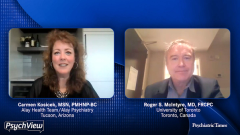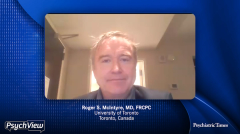
GABAa Receptor Modulators for Treatment of MDD
Experts in psychiatry comment on the use of GABAa receptor modulators in the treatment of major depressive disorder (MDD), highlighting zuranolone.
Episodes in this series

Carmen Kosicek, MSN, PMHNP-BC: Let’s talk about it then from the [perspective of the] people who are in clinical practice, of exactly what you just said and bounced off of, whether it’s in an urban, let’s say, a big medical center or if it’s suburban or rural. So, from there, how I think of the medications is, where can I have access to these? For example, many of the products that you mentioned, the ketamine products, are absolutely fantastic, but sometimes they can be limiting [based] on where they can get them. That does not mean that they should not be spoken about by the provider because there are many centers all around you, whether they’re private centers or even with the big institutions where patients can go and get them. Is that what you’re also seeing, Roger?
Roger S. McIntyre, MD, FRCPC: Absolutely it is. And I think that you’re touching on something that I think is really not an elephant, but whatever is bigger, in the room in the sense that the ability to access in a timely way these treatments in a way that’s part of a coordinated, accountable, longitudinal health care system. And I think that one of the questions that emanates from this discussion is what [is] the expertise [needed]? What type of setting is required for these treatments? And certainly esketamine and ketamine require a certain level of infrastructure and personnel and professional competencies as well as in the case of esketamine or REMS [risk evaluation and mitigation strategy]. Fortunately for dextromethorphan-bupropion it does not. It can be prescribed by health care providers. And that’s also the case now for zuranolone, the GABAergic [treatment]. Just thinking out loud here, I’m sure some of our colleagues are saying, “Are they saying ‘GABA’? How did that get into this conversation?” We understand serotonin. We’ve been working with that at that altar for so long. I think many colleagues have certainly been hearing about glutamate, given its integral role in brain tropism and brain plasticity. They think people have been hearing about that at conferences and no doubt reading about it just as part of the CME [continuing medical education]. GABA has not historically been a focal point in our conversation about the alleged pathophysiology of depression and/or treatment. And some might be saying, “[It] isn’t the same target is the benzodiazepines. Benzodiazepines aren’t antidepressants, they can worsen depression. So what are these [people] talking about?” Well, GABA is interesting because GABA is the most abundant inhibitory neurotransmitter. It’s sort of the opposite side of the seesaw, glutamate being the most abundant excitatory. GABA has many different receptors just like glutamate and broadly, and maybe just keep this sort of digestible, that the GABA receptors are located in different parts of the brain, in different parts of the of this cellular communication. So we always hear that location, location, location matters for everything in life. And that’s the case for GABA receptors, and some of these GABA receptors are located inside the synapse. Some of these GABA receptors are located outside…in a different synapse, that’s called the extrasynaptic GABA system. In other words, they are in other neural pathways. So, we have synaptic, and we have extrasynaptic. It gets complicated and there are different types of GABA, 1 is called GABAA, and we can find these GABAA receptors inside the GABA intercommunication pathway and also in other systems. What’s really interesting is—[it’s] far too much detail because they get different subtypes—but the gist of it is that benzodiazepines, which are not antidepressant, can worsen depression. They bind to a different type of and [a] different location of GABA receptors than do some of the newer agents like zuranolone. Zuranolone is a GABAergic treatment, and it binds, yes, inside synapse, but also to these receptors outside the synapse. In other words, it’s in the same category. It’s a GABAergic, but location, location, location, but also the type of effect it has and the functional effect it has is completely different than benzodiazepines. There’s a mountain of data to show that in the brain of people living with depression, there’s something wrong with GABA signaling, and the GABA signaling is not regulated quite right. In some cases, we see a loss of GABA availability. So the theory is maybe we can treat depression by replenishing the GABA signal and remodulating it with a medicine that’s GABAergic but not a benzodiazepine. It has to target this sweet sound location, location, location, these other types of GABA receptors. And that’s been shown now not just in so-called animal preclinical models, but also in patients. It’s been FDA approved to rapidly improve depressive symptoms. Pretty cool.
Carmen Kosicek, MSN, PMHNP-BC: Exactly what you’re saying, like it’s a new [medication], but it’s not a [very] new [medication] because, again, we can utilize IV [intravenous] [treatment] for postpartum depression. Thinking about how severe that is, especially to be noticed in that short of a duration after having a child and that it’s been utilized there. So it’s bouncing off all of that same type of information to expand its coverage. Additionally, it was for IV [use] before; it starts that way with a lot of medications. Look at how ketamine was stereotypically IV before. But now to take it to a much broader patient population pool. So when I explained to patients about zuranolone of what’s coming, it works, [it’s] a steroid type of model of replenishing the body, what it normally has, and kind of like resetting it on its own. It’s new, but it’s not really new. And I say it that way all the time to patients because there’s been, for whatever reason, the mistrust of new medications. But yet this isn’t [like that]; these are new medications that already have extended trial data, not a new medication that’s just been thought of and used. That’s not how it goes. So when you then showcase that to a patient of here’s what the choices are that are out there, we can continue to do the same thing and not upgrade the technology with the SSRIs [selective serotonin reuptake inhibitors] that are not helping you. Here’s the path, here’s the trajectory of what is available or even what’s coming. I think that that’s really imperative for providers, to slowly start digesting for themselves to learn, and then also to paint the picture of hope. The clinical trial of where they are with this medication to [use it] for everyone with MDD [major depressive disorder] is getting closer and closer.
Roger S. McIntyre, MD, FRCPC: Absolutely. And your point is well taken. There is, in fact, a long runway with respect to [the] mechanism of these medications. And you’re really touching on something really interesting. You mentioned steroids. And some people are probably thinking, “Wow, these guys are touching on things like, what are you talking about? Steroids?” Yeah. So, in the brain, the brain has its own indigenously produced steroids called neurosteroids. And they are derived ultimately from cholesterol, but they are produced locally in the brain. They’re modulated by a variety of factors, including but not limited to, for example, sex steroids. So we have these steroids produced in the brain. And for those who are joining us, some people like some of the detail, I know for others it’s maybe not quite their cup of tea, but for those who like the detail, there’s a steroid known as allopregnanolone. And allopregnanolone is a well-known steroid been studied…for decades. And it’s known to have an effect in the brain. That is, to have a brain therapeutic effect, also be having effects on tropism and plasticity and reducing anxiety and depression. And you mentioned IV, [there is] a drug, brexanolone. Brexanolone is effectively out right now. it’s effectively the same thing. It’s a proprietary allopregnanolone, and it’s been approved by FDA for a few years now [for] IV administration [to treat] postpartum depression. More recently, zuranolone, which sounds a lot like brexanolone,…is different. It’s oral. That’s a big difference versus IV. And it is a synthetic. It’s not a natural allopregnanolone; it’s a synthetic that mimics the effect of that particular steroid and [was] recently approved in the adult [population] with postpartum depression alone or adjunct to whatever other treatment they’re having. There are also investigations underway in people who don’t have major postpartum depression [but who] may have major depressive disorder that’s not pregnancy-associated with it.
Transcript is AI-generated and edited for clarity and readability.
Newsletter
Receive trusted psychiatric news, expert analysis, and clinical insights — subscribe today to support your practice and your patients.















